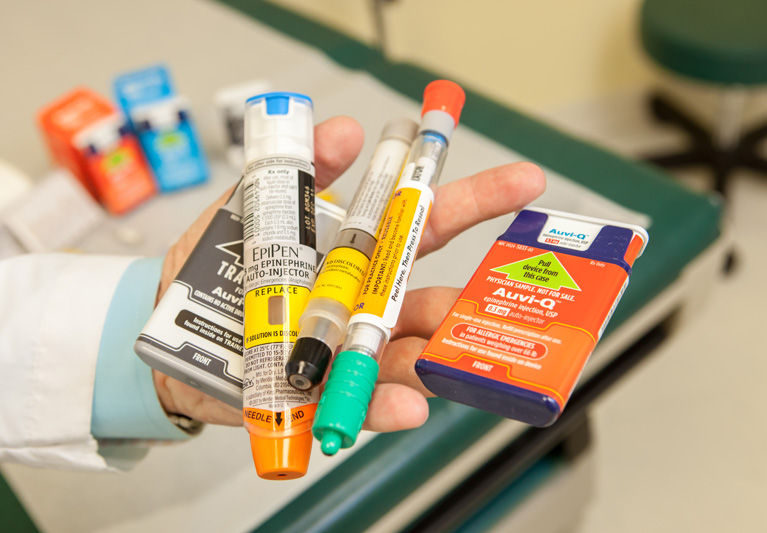
Vero Beach’s Dr. Michael Wein, board certified in both allergy and internal medicine, is taking a “shot” at state and federal regulations governing the treatment of anaphylaxis in a study just published in the current issue of the Annals of Allergy, Asthma & Immunology.
What’s anaphylaxis? The Mayo Clinic defines it as a severe, potentially life-threatening allergic reaction. It can occur within seconds or minutes after exposure to something an individual is allergic to such as peanuts or the venom from an insect sting.
The flood of chemicals that a person’s immune system releases in response to that peanut or sting can send him or her into shock, drop blood pressure precipitously and constrict airways. Signs and symptoms of anaphylaxis may also include a rapid, weak pulse, a skin rash, nausea, vomiting and a swollen tongue.
The most common triggers of anaphylaxis include foods such as peanuts, tree nuts, (including walnuts, pecans, almonds, macadamia nuts and pistachios), eggs, wheat, shellfish and soy as well as insect venom, latex and even some medications.
According to the American College of Allergy, Asthma and Immunology, anaphylaxis requires immediate medical treatment, including an injection or shot of epinephrine. If anaphylaxis isn’t treated promptly and properly, it can be fatal. (Epinephrine, more commonly called adrenaline, helps open the airways to reduce breathing difficulties and narrows the blood vessels which combats low blood pressure.)
In a case that represents every parent and grandparent’s worst nightmare, a teenage honor student, home from his freshman year at college, shared half a single cookie with a friend. Within hours, that young man lay dead in a hospital emergency room.
Neither the boy nor his friend was aware the cookie they shared had been made with peanut oil, a substance to which the young college student was highly allergic.
What’s even worse is there may have been a lifesaver right at hand.
The boy’s mother was able to locate one of her son’s epinephrine auto-injectors but she was instructed by a 911 first responder not to use it.
Why? Because that particular epinephrine auto-injector, (EAI) was two months past its expiration date and current laws would have made that first responder liable had he instructed the mother to use it and anything went wrong.
Instead, the worst thing that could possibly have gone wrong did go wrong. The boy died.
Wein, a graduate of Brown University in Providence, RI and Johns Hopkins in Baltimore, MD wanted to know more. No stranger to research, he had already published multiple studies collaboratively with doctors at Duke University, Johns Hopkins and other prominent medical facilities, so with the help of his many Vero Beach patients, he decided to look into the issue of expiration dates on EAIs.
Wein’s patients volunteered to give him their expired EAIs and he analyzed the contents.
What he found was shocking.
“All EAIs that were no more than 24 months past their expiration date contained more than 90 percent of the labeled epinephrine dose,” says Wein’s study. That meets or exceeds the current U.S. Pharmacopeia standards for a new EAI. Indeed, even EAIs that were 24-36 months (two-to-three years) past expiration “contained 84.2 to 95.7 percent of the labeled dose.”
The obvious conclusion is the EAI that distraught college student’s mother had found – which was only two months past its expiration date – very likely had a more than enough epinephrine to save the boy’s life.
At least that’s the conclusion Wein’s study makes when it says, “old epinephrine is probably better than no epinephrine” and “since expired injectable epinephrine kits – even those that are many years old – contain a significant amount of the original intended does of epinephrine, they should be used to treat anaphylaxis if there is no other epinephrine around. The potential benefit of receiving a smaller-than-ideal dose of epinephrine would likely outweigh the danger of using an expired injectable epinephrine kit.”
Since the Centers for Disease Control and Prevention says “every three minutes a food allergy reaction sends someone in this country to the emergency room,” Wein’s study paves the way for future research and in the interim provides sound, tangible advice that could well apply to more than 200,000 Americans each year.
Food Allergy and Research, a non-profit 501-C-3 research group, claims that “up to 15 million Americans have food allergies,” and in yet another potential nightmare for parents and grandparents, the CDC reports “at least three million American children suffer from a food or digestive allergy and the problem is growing.”
In fact, the CDC says, food allergies among children increased a whopping 50 percent between 1997 and 2011 and that trend shows no sign of letting up.
Wein says that today food allergies now affect four to six percent of all children in the United States, and he says, “the incidence is clearly increasing.”
The professorial Wein, who teaches medical students at Florida State University in addition to running his Vero practice and acting as the chief of allergy and immunology at Indian River Medical Center, gets truly animated when talking about the impact of food allergies on children, in part because he knows what they are going through.
“As a kid,” he says, “I took allergy shots every Thursday.”
Dr. Wein’s pediatric and adult allergy and immunology practice is at 3375 20th Street in Vero Beach. The phone is 772-299-7299. He also has a website and Facebook page.



